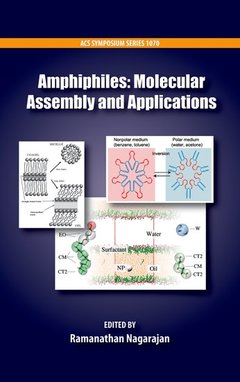Description
Amphiphiles
Molecular Assembly and Applications
ACS Symposium Series, Vol. 1070
Coordinator: Nagarajan Ramanathan
Language: English
Subjects for Amphiphiles:
Publication date: 04-2012
344 p. · 16x22.2 cm · Hardback
344 p. · 16x22.2 cm · Hardback
Description
/li>Contents
/li>Biography
/li>
Amphiphilic molecules displaying characteristic self-assembly behavior, generating nanoscale structures, are being widely exploited in materials, energy, pharmaceutical and biomedical technologies. There is great interest in the design of amphiphiles tailored for specific applications. This book introduces the reader to recent advances in this field incorporating studies on a variety of amphiphiles including surfactants with novel ionic head groups, surfactants with chirality, peptoid amphiphiles, block copolymers, block polyelectrolytes, amphiphilic inverted polymers, adhesive peptide amphiphiles and amphipolar polymers. The molecular structural features of amphiphiles and their impact on self-assembly and/or potential applications are considered in all of the chapters. Examples of the amphiphilic systems and applications covered in the book include pyridinum based amphiphiles for gene delivery, peptoid amphiphiles that control inorganic nanoparticle growth, carbohydrate surfactants for food applications, amphipolar block copolymers for emulsion polymerization, polymer grafted surfaces to control biofouling of medical equipment, peptide amphiphiles with strong adhesive characteristics to produce nanoscale adhesion pads, use of block copolymers as templates to generate mesoporous organosilicas, photopolymerization of resorcinarene thiol-ene surfactant to produce nanocapsules, preparation of polymer microcapsules encapsulating hydrophobes and amphiphilic invertible polymers that allow applications in both polar and non-polar solvents. Novel characterization methods have been employed to discern the structure and morphology of the amphiphile generated nanostructures. These include use of AFM, FTIR and ellipsometry to characterize polyelectrolyte complexes for fuel cell membrane applications, electrokinetic sonic amplitude method to characterize ionic block copolymers adsorption on pigment particles, SAXS, light scattering and neutron reflectivity to characterize zwitterionic polymer brushes, surface acoustic spectroscopy to characterize surfactant adsorption in the presence of counterions, and QCM-D to characterize surfactant adsorption on hydrophobic SAM surfaces. The book also includes computer simulation studies to predict assembly of nanoparticles and surfactants at the oil-water interface.
1. Amphiphilic Surfactants and Amphiphilic Polymers: Principles of Molecular Assembly. 2. Pyridinium Amphiphiles in Gene Delivery - Present and Perspectives. 3. Artificial Polymers Mimic Bacteriophage Capsid Proteins To Protect and Functionalize Nucleic Acid Structures. 4. Screening of Basic Properties of Amphiphilic Molecular Structures for Colloidal System Formation and Stability. 5. Levo vs. Dextro. 6. Oil-in-Oil-Emulsions: Tailor-Made Amphipolar Emulsifiers. 7. Fluorinated Hydrogen Bonded Electrolytes of PVA/NafionRG and PAH/NafionRG Complexes. 8. Structure Formation of Adsorption Layers of Ionic-Amphiphilic Copolymers on Inorganic and Organic Pigment Surfaces As Studied by ESA. 9. Salt Concentration Dependence of Swelling States for Poly(sulfobetaine) Brush at Aqueous Solution Interface. 10. Ultrasonic Rheology of Mixed-Phase Systems. 11. Effect of Hydrophobization of Gold QCM-D Crystals on Surfactant Adsorption at the Solid-Liquid Interface. 12. Thermally Treated Octadecylphosphonic Acid Thin Film Grown on SS316L and its Stability in Aqueous Environment. 13. Amphiphilic Invertible Polymers (AIPs). 14. Surface-Attached, Polymerized Vesicles Exposing Adhesive Peptide Functionalities. 15. Synthesis of Large-Pore Periodic Mesoporous Organosilicas Using Hexane as Swelling Agent. 16. Template-Free Synthesis and in Situ Functionalization of Nanocapsules. 17. Synthesis of Oil Core/Polymer-Shell Particles via Miniemulsion Templating. 18. Molecular Dynamics Simulations of Nanoparticles and Surfactants at Oil/Water Interfaces.
Dr. Nagarajan is Emeritus Professor of Chemical Engineering at The Pennsylvania State University and is currently a research scientist at the Natick Soldier Research, Development & Engineering Center. His research interests span the fundamentals and applications of soft nanoparticles, particularly those generated by self-assembly of surfactant and block copolymer molecules. He has authored approximately 100 publications which have been cited over 3000 times with an H index of 30, and is co-editor of the ACS Symposium Series books Nanoparticles: Synthesis, Stabilization, Passivation and Functionalization and Nanoscience and Nanotechnology for Chemical and Biological Defense.
© 2024 LAVOISIER S.A.S.
These books may interest you

Mixed Surfactant Systems 56.31 €



